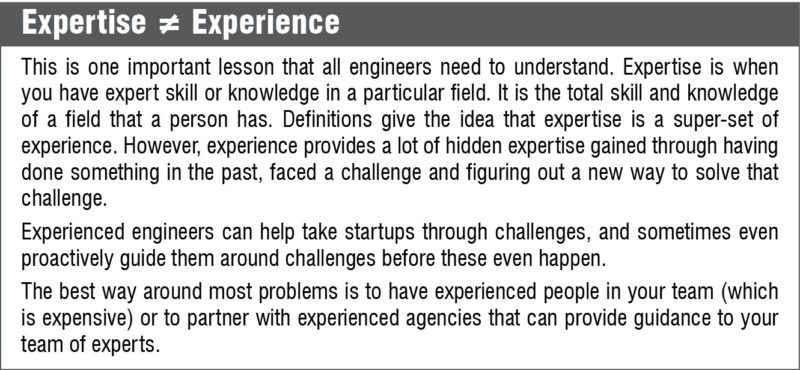Developing a project from scratch is every designer’s dream. Unfortunately, most ideas are not designed for manufacturing from the beginning. Often, the changes required are significant enough to prevent a product from even shipping. Tony Fadell, known as one of fathers of iPod, said at a conference, “There is a reason they call it hardware—it is hard.”

This does not mean it is impossible, but the designers require access to not only the components and equipment for design, but also the know-how to put it together into a functional product. This means ensuring that their design can be built by the limited capabilities of a manufacturing facility or withstand the noisy analogue world we live in.
This article will give you an industry veteran’s take on the best way to reduce time-to-market for a successful design while ensuring you do not draw flak from your investors.

OpEx is better than CapEx
While there are advantages to having state-of-the-art test equipment in your lab, design houses still find it difficult to get experienced design and test engineers who are capable of crafting test strategies and executing test automation and design. Adding the cost of experienced engineers and high-end equipment together is enough to make most angel investors fly away.
One way to overcome this challenge is to outsource certain elements of design and test to service providers. This ensures that your team focuses on ensuring that the core competencies of your product are delivered.
Everyone loves a smaller bill
There are two ways in which you can lower costs. One is by having your bill of materials (BoM) optimised, and second is by reducing the design cycle time so that you are able to push out two projects or revisions in the time of one.
Most startups begin prototyping on Arduino or use 3D printing for certain components. These methods are almost always way too expensive to be taken to market and do not scale well. You need to move on to a custom-designed circuit board that delivers the feature set you need and nothing else. This is where elements like the power supply and peripherals that you took for granted earlier begin hatching plans to ditch you.
What you could do here is to put together the proof-of-concept, no matter how bulky it is, and then approach the manufacturer to communicate your idea. The manufacturer will help you in refining the design further.
You can also optimise your BoM by speaking to the design teams at semiconductor vendors, distributors or even at certain electronics manufacturing service providers. Sometimes, certain manufacturers may be able to let you get lower prices on components by piggy-backing on another order and, thus, combining the volume of two projects to bring down prices.
Nobody likes iterating over and over
Always remember to take great care of your mechanical design. Because no matter how nice your 3D-printed version looks, you will now need to work with real computer-aided design tools to design something that works within the tolerances of your manufacturer. Not to mention ensuring that the structure is strong and robust enough to work after being manhandled during the delivery process.
You will also need to account for that product’s use cases. A completely-sealed housing might get your product to work in your air-conditioned lab but may fizzle out when used in the mid-day Sun. Any mistake made in the manufacturing stage could set you back by a lot of time. Re-tooling is expensive and an expense that you can only avoid by being careful.
Design for manufacturing is the most important part here, and there is no easy way out of it. Connecting with manufacturers early on is one good idea that you can try by using your personal network, your investor’s network, forums or meeting these firms at exhibitions and conferences.
Your relationship with your component vendor, supplier and manufacturer are all very important. But always remember that a component vendor will always try to push their own components over competitors’ (they are running a business after all). The best way to ensure unbiased input is to work with one of the many distributors since they represent a large number of vendors together. This could also help you benefit from a more comprehensive BoM optimisation than what would have been possible earlier.

Testing without spending a bomb
Test equipment is very useful but often quite expensive. These are a must-have for any design house, but not all startups have the funds to afford such a lab—not to mention the staff to run it. Working with a testing service provider or facility will let you make the most of their expertise at a much lower cost.
The other bonus of working with a testing service provider is that you will very often get free design help without having to explicitly pay for it. Test service providers are perfectly positioned to employ the best engineers available in the industry because use of their skills at a testing facility are maximised. Getting an experienced pair of eyes to look at your products and review could help you identify quirks or implement tweaks that could help take your product up a notch.
We once had a firm that wanted to get Federal Communications Commission (FCC) certification for a wireless product that they had designed. Since it is pretty expensive to get FCC certification where the process is an arduous one, they got their products tested and fine-tuned by external authorities before they were confident enough to attempt and get it FCC-certified, which they eventually did. The customer not only saved a lot of money in the process, but also precious time-to-market.
However, more often than not, standalone testing labs charge for pay-per-use scenario, and you end up doing just the testing. Some companies like Avnet India are now coming out with testing as a service. As previously seen in the software testing space, testing as a service lets you leverage test equipment in addition to design service consultation, schematic and layout design and review, firmware development, and final design testing and verification.
Go ahead, make your investor proud
Whether it is an angel investor in the form of your family or a venture capitalist who trusts you to multiply his money, startups owe them a successful project.
Today, we are living in a world where we can give startups a faster start. The objective for any successful project is faster time-to-market. Advice shared in this article is not about addressing a lack of skills, but to optimise the way you leverage people around you to save money and time.
Ramani Sundaresan is managing director, Avnet India
Dilin Anand is executive editor at EFY. He is B.Tech in ECE from University of Calicut, and MBA from Christ University, Bengaluru










